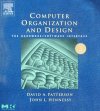CS 441 - Computer Architecture
|
Meeting time: TR 9:45-11:15am
Room 107 Chapman
Building
University of Alaska Fairbanks
|
UAF CS F441-F01
3.0 Credits, Fall
2009
Prerequisites: CS 321 (OS), EE 341
|
Instructor: Dr. O. Lawlor
lawlor@alaska.edu,
474-7678
Office: 201E Chapman
Hours: 11:15-noon TR, by
appointment, or just drop by!
|
|

|
Recommended Textbook:
Computer
Organization and Design: The Hardware/Software Interface, David
Patterson and John Hennessy, Morgan Kaufmann, 3rd Edition.
|
ADA Compliance: Will work with Office of
Disabilities Services (203 WHIT, 474-7043) to provide reasonable
accommodation to students with disabilities.
|
Course Website:
http://www.cs.uaf.edu/2009/fall/cs441
|
Course Goals and Requirements
By the end of the course, you
will be able to understand both the present and future of computer
design for performance. Specifically, we will cover instruction-level
parallelism, including pipelining, vector processing, SWAR, SIMD,
out-of-order execution, and multi-issue; as well as coarser-grained
parallelism, including multicore, multi-thread, distributed-memory,
and GPU programming. To understand this, you will need to know at
least the following topics from the course prerequisites:
From
CS321 (OS), and its prerequisite CS301 (Assembly)
Bits,
binary, hex, octal, bitwise operations (like & | ~ ^ <<
>>), and why they matter
Basic
computer hardware: CPU, arithmetic, floating-point, cache, RAM,
disk, network
Threads,
processes, virtual memory, paging, shared memory, concurrency, task
switching
From
EE 341, and its prerequisite Physics 212
Resistance,
capacitance, and how they affect circuit wiring at high speeds and
long distances
Logic
gates: and, or, not, xor, nand, nor, and how they're useful to
build circuits
Glue logic: busses,
mux/demux, flip-flops, and how to build circuits with them
Calendar
Last day to drop: Friday, September 18. Midterm exam: Tuesday,
October 20. Last day to withdraw: Friday, October 30. Thanksgiving
Break: Thursday, November 26-Sunday, November 29. Last class:
Thursday, December 10. Final exam: 8am Thursday, December 17.
Student Resources
Academic Help: Google, Rasmuson Library, Academic Advising Center
(509 Gruening, 474-6396), Math Lab (Chapman Room 305), English
Writing Center (801 Gruening Bldg, 478-5246).
Grading
Your work will be evaluated
on correctness, rationale, and insight, not on successful
regurgitation of random trivia. Grades for each assignment and test
may be curved up or down if needed. Your grade is then computed based
on four categories of work:
HW:
Homeworks and machine problems, to be distributed through the
semester.
PROJ1:
a paper and in-class presentation on an architecture topic of your
choice, due in October.
PROJ2:
a software development or hardware performance analysis project, due
in December.
MT:
Midterm Exam, Tuesday, October 20.
FINAL: Final Exam
(comprehensive), 8am Tuesday, December 16.
Your overall score is then
calculated as:
GRADE = 15% HW + 15% PROJ1 + 15% PROJ2+ 25% MT +
30% FINAL
This percentage score is transformed into
a plus-minus letter grade via these cutoffs: A >= 93%; A- 90%; B+
87%; B 83%; B- 80%; C+ 77%; C 70%; D+ 67%; D 63%; D- 60%; F. The
grades “C-”, “F+”, and “F-” will
not be given. “A+” is reserved for truly extraordinary
work.
At my discretion, I may round
your grade up if it is near a grading boundary. Homeworks are
due at midnight on the day they are due. Late homeworks will receive
no credit. At my discretion, I may allow late work without
penalty when due to circumstances beyond your control. Projects
that are up to two weeks late may be accepted at a 50% grade penalty
(e.g., on-time grade: 86%; late grade: 43%). Everything you turn in
must be your own work--violations of the UAF Honor code will
result in a minimum penalty equal to THAT ENTIRE SECTION OF YOUR
GRADE (e.g., one plagiarized homework question will negate an
otherwise perfect grade on all homeworks). However, even substantial
reuse of other people's work is fine (and not plagiarism) if it is
clearly cited; you'll be graded on what you've added to others'
work. Group projects (NOT homeworks) are acceptable iff you
clearly label who did what work; but I do expect a two-person group
project to represent twice as much work as a one-person project.
Department policy does not allow tests to be taken early; but in
extraordinary circumstances may be taken late. In extraordinary
circumstances, such as an infectious disease outbreak, classes may be
held on Blackboard/Elluminate Live.
Course Outline (Tentative)
|
First section: Make One CPU Faster (1950-2000 AD)
History & Trends: Digital
Logic, Von Neumann machines
Performance, timing, NetRun
Physical Reality
Speeding Up Arithmetic
Speeding Up Memory
Cache hardware design,
thrashing
Cache hit ratio, performance modeling
|
Second Section: Make More CPUs (2000+ AD)
|
![]()